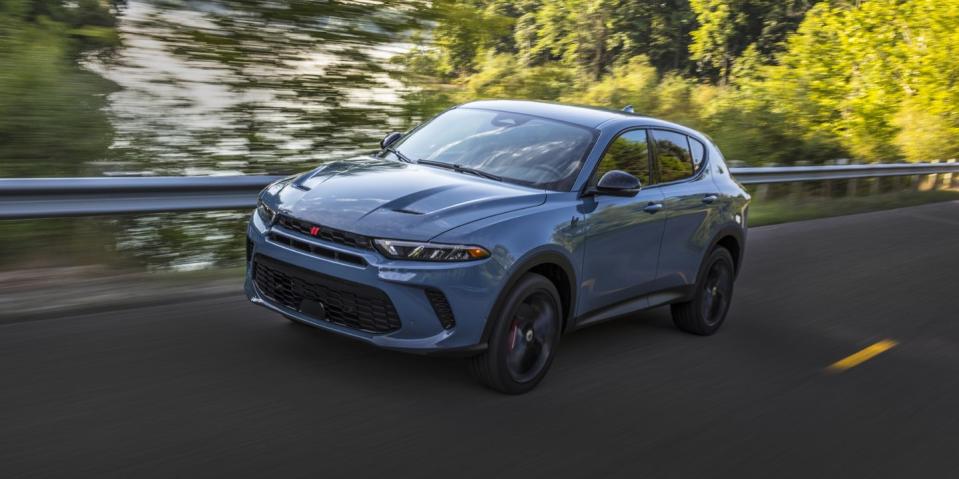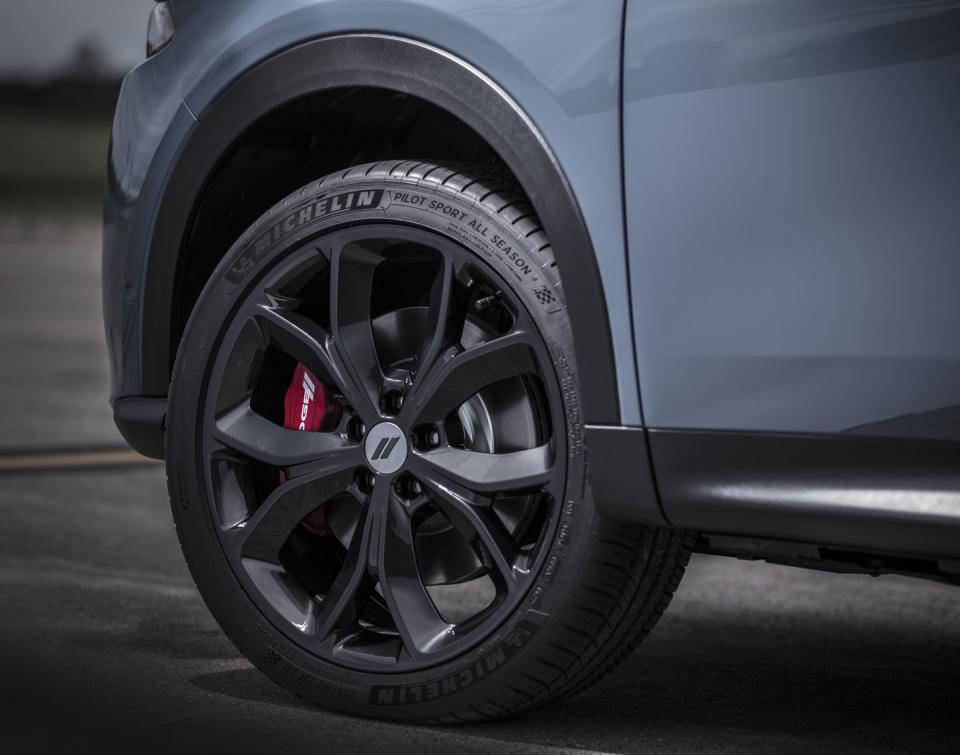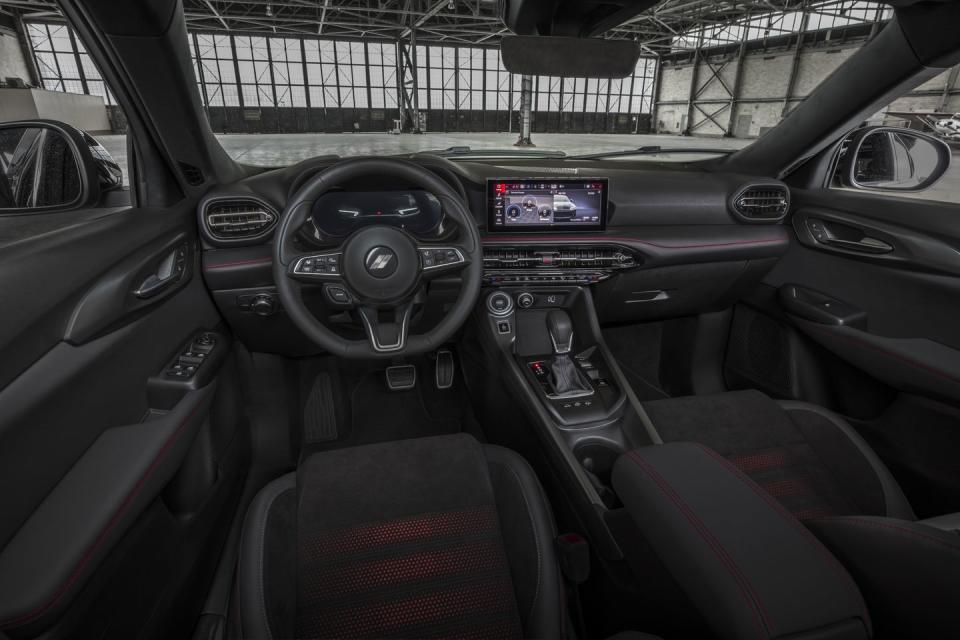The 2023 Dodge Hornet Breathes Life into Dodge

The Hornet brings Dodge back to the compact segment with an all-wheel-drive, 268-hp base model and a 288-hp PHEV variant that packs 383 lb-ft of torque.
The 2023 Dodge Hornet GT starts at $31,590, including destination, and is hitting dealers shortly.
Dodge packs adaptive cruise control, blind-spot detection and a 10.25-inch touchscreen as standard equipment.
Since the Neon, Dodge’s compacts haven’t always risen to the top of the mountain. The Caliber was an interesting take on a hatchback, and the Dart tried to revive one of Dodge’s legendary nameplates, but neither seemed to resonate. When the Dart went to the great assembly line in the sky, Dodge didn’t replace it. Instead, the company leaned further on its Durango, Charger and Challenger. In hindsight, that was an interesting and fun move.
Though, with the looming demise of the current generations of Charger and Challenger, and a fervent demand for compact crossovers, Dodge has a big hole to fill. So, the brand is jumping back into the compact sphere with its Italian-born Hornet, and the company is applying what it learned from the muscle car craze.
Dodge splits the Hornet down the middle based on the powertrain. The entry-level model is the GT, which sports a 2.0-liter turbocharged Hurricane I4 that sends 268 hp and 295 lb-ft of torque through a nine-speed automatic transmission and to all four wheels.
The more powerful R/T model pivots toward plug-in hybrid power with a 1.3-liter gasoline-burning turbocharged I4 that’s paired with an electric motor at the rear axle and an engine-mounted starter generator. Combined, this powertrain sends 288 hp and 383 lb-ft of torque to the wheels. Attached to the R/T’s internal-combustion mill is a six-speed automatic transmission.
While these figures are interesting on paper, on the road they translate, well, exactly as you’d expect. Sitting in the GT, the turbocharged I4 delivers enough power through your right foot to not contest too many maneuvers. Ramping up to highway speed is only a few seconds away. While the initial launch is on the more conservative side with a soft throttle input, switching to sport mode makes initial throttle inputs more aggressive and exciting.
The R/T models, on the other hand, are much livelier from a standing start. Despite a smaller ICE, the electric rear motor helps compensate at lower engine speeds. According to Dodge, the Hornet R/T sprints to 60 mph in only 5.6 seconds. While that’s not exactly supercar levels of performance, accelerating in the Hornet R/T is genuinely surprising. That sprint to 60 mph includes the overboost feature dubbed PowerShot from the R/T’s hybrid system, which gives you 30 extra horsepower for 15 seconds while pulling back on the paddle shifters.

This higher performance approach also seems to penalize the Hornet on fuel economy. While we didn’t note real-world fuel economy, Dodge says the Hornet nets 21 mpg city, 29 mpg highway, and 24 combined mpg. Comparing that to base Mazda CX-5s and Honda HR-V’s might not be totally fair considering the performance difference, but that is always a tradeoff. The official fuel economy hasn’t been released on the R/T, but those numbers should rise despite making more power than the base GT.
Dodge’s performance approach doesn’t stop with the powertrain. Stock Hornets see Koni shock absorbers on all four corners. Selecting the Track Pack replaces those Konis with two-stage adjustable dampers that respond to your drive mode selection.
Four-piston Brembo front calipers are included in the Track Pack, along with a set of 20-inch wheels replacing the standard 17-inch units. These 20-inch wheels are wrapped in 235/40 rubber. If you want any of those goodies, and don’t want to spend the extra money on the quicker R/T model, Dodge will throw the Track Pack on a GT.
The Track Pack-equipped GT handles the road in its normal drive mode without too much pain and suffering. The relatively narrow sidewall might struggle managing craters in northern roads, but the adjustable suspension works. In the standard drive mode, the light bumps and washboards in the road largely avoid the cabin. Though, if you want to get a better feel for the road, switching into sport mode will firm the suspension enough to remind you that the road surface isn’t as smooth as you remembered.
While the ’23 Hornet is fun to drive—and does a good job at blurring the lines between a mainstream compact crossover and a hot hatch—for those who care more about consumer features, the Hornet has those too. Sitting in the middle of the dash is the standard 10.25-inch touchscreen display that runs Dodge’s Uconnect 5 infotainment system.
Apple CarPlay and Android Auto are both standard, but wireless connection is on higher trimmed variants. Regardless of choice, the large screen works well and is easy to navigate. The CarPlay screen does show up awkwardly and takes a little time to adjust to the aspect ratio.
Adaptive cruise control is also standard issue across the board, and Dodge packs in its other advanced driver-assistance systems as standard, too. That includes blind-spot detection, lane-departure warning, and automatic emergency braking. Adding the Tech Package onto your Hornet nets you intelligent speed assist with traffic sign recognition, active lane keeping, and a driver-attention assist system to monitor that the driver is focusing on driving. The package also includes intelligent adaptive cruise control, which supports stop-and-go driving.
The standard adaptive cruise control system works well, with easy-to-use steering wheel controls. The lack of sign recognition means you’ll have to pay attention to signs while you’re driving, which seems reasonable. The intelligent adaptive cruise control does make that a lighter lift, though the system struggles with awkward speed transitions and can confuse what road you’re on, and give the vehicle the incorrect speed sign.
That aside, it also works well in dealing with the rigors of highway driving. The Tech Package’s lane-keeping system isn’t invasive but does nudge you back into the correct lane when your vehicle wanders. We’ll have to take Dodge’s word about the emergency braking being up to snuff, as we didn’t have an opportunity to put this to a real-world test.

Naturally, you’ll spend most of your time with the Hornet on the inside. Joining the aforementioned 10.25-inch touchscreen, you’ll find a standard 12.3-inch digital gauge cluster. The instrument cluster does exactly what it needs to do: clearly relays your vehicle information. The rest of the interior is tied to option packages, with cloth and leatherette as standard, while the plus model moves up to leather. Optional red perforated leather is available too, for those inclined.
Dodge’s most interesting seats are attached to the Track Pack. These seats are covered in perforated black Alcantara that has red accents visible through the perforations. These Track seats aren’t heavily bolstered and are fairly wide. The track package also includes a leather-wrapped sport steering wheel, and its shape is consistent across Hornet and is well-designed and ergonomically laid out.
Behind the driver, you’ll find a comfortable second row and cargo area, which advertises 27 cubic feet in GT trim and 22.9 cubic feet for R/T models. That discrepancy comes from the 15.5-kWh Lithium-ion, nickel manganese cobalt graphite battery that’s stored back there. The cargo area isn’t exactly cavernous but should handle your daily grind similar to your current hatchback.
All in, the Hornet shoots beyond the Dart and is a promising step forward for Dodge’s compact car game. While the Hornet’s performance isn’t quite up to the hyper hatch levels we see with the Volkswagen Golf R, it is close to the hilariously absurd Hyundai Kona N with straight-line speed. Though, we don’t doubt the Hornet will get an even sportier trim down the line to further shrink that 0-60 time.
Comparing it to similarly priced competition from Mazda, Honda, and Ford, the Hornet might be looking for a new, performance-for-dollar buyer that doesn’t want to drop big bucks on a sporty trim but doesn’t mind taking a few mpg dings in fuel economy. After all, Dodge doesn’t want to pivot away from its performance image.
The Dodge Hornet GT should start hitting your local dealer soon. The base Hornet GT will set you back $31,590 including destination, with the Track Pack tacking on another $2995. Jumping up to the R/T, you’ll see the price climb to $36,947 when these start to hit dealers later this year as a 2024 model.
Do you think the Hornet will be enough to help Dodge make gains with a smaller car? Tell us your thoughts below.

 Yahoo Autos
Yahoo Autos 